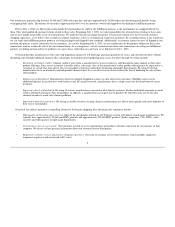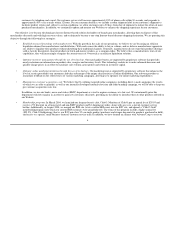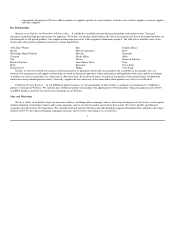Overstock.com 2004 Annual Report Download - page 19
Download and view the complete annual report
Please find page 19 of the 2004 Overstock.com annual report below. You can navigate through the pages in the report by either clicking on the pages listed below, or by using the keyword search tool below to find specific information within the annual report.
services, which can have an adverse effect on our customers' satisfaction with us. In any of these circumstances, we may be unable to engage alternative
carriers on a timely basis, upon terms favorable to us, or at all. Changing carriers would likely have a negative effect on our business, prospects, operating
results and financial condition. Potential adverse consequences include:
reduced visibility of order status and package tracking;
delays in order processing and product delivery;
increased cost of delivery, resulting in reduced gross margins; and
reduced shipment quality, which may result in damaged products and customer dissatisfaction.
A significant number of merchandise returns could harm our business, financial condition and results of operations.
We allow our customers to return products and, beginning July 1, 2003, we started accepting returns of products sold through our fulfillment partners.
We modify our policies relating to returns from time to time, and any policies intended to reduce the number of product returns may result in customer
dissatisfaction and fewer return customers. If merchandise returns are significant, our business, prospects, financial condition and results of operations could
be harmed.
If the products that we offer on our Websites do not reflect our customers' tastes and preferences, our sales and profit margins would decrease.
Our success depends in part on our ability to offer products that reflect consumers' tastes and preferences. Consumers' tastes are subject to frequent,
significant and sometimes unpredictable changes. Because the products that we sell typically consist of manufacturers' and retailers' excess inventory, we have
limited control over the specific products that we are able to offer for sale. If our merchandise fails to satisfy customers' tastes or respond to changes in
customer preferences, our sales could suffer and we could be required to mark down unsold inventory which would depress our profit margins. In addition,
any failure to offer products in line with customers' preferences could allow our competitors to gain market share. This could have an adverse effect on our
business, prospects, results of operations and financial condition.
We face risks relating to our inventory.
We directly purchase some of the merchandise that we sell on our Websites. We assume the inventory damage, theft and obsolescence risks, as well as
price erosion risks for products that we purchase directly. These risks are especially significant because some of the merchandise we sell on our Websites are
characterized by rapid technological change, obsolescence and price erosion (for example, computer hardware, software and consumer electronics), and
because we sometimes make large purchases of particular types of inventory. In addition, we often do not receive warranties on the merchandise we purchase.
Further, beginning July 1, 2003, we started accepting returns of products sold through our fulfillment partners, and we have the risk of reselling the returned
products.
In the recent past, we have recorded charges for obsolete inventory and have had to sell certain merchandise at a discount or loss. It is impossible to
determine with certainty whether an item will sell for more than the price we pay for it. Because we rely heavily on purchased inventory, our success will
depend on our ability to liquidate our inventory rapidly, the ability of our buying staff to purchase inventory at attractive prices relative to its resale value and
our ability to manage customer returns and the shrinkage resulting from theft, loss and misrecording of inventory. If we are unsuccessful in any of these areas,
we may be forced to sell our inventory at a discount or loss.
15
•
•
•
•
























